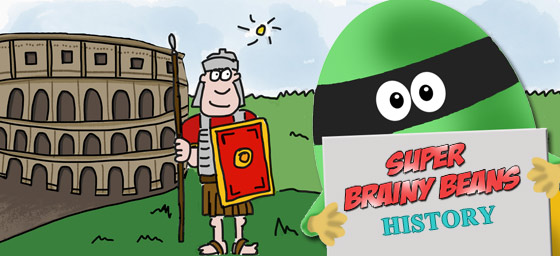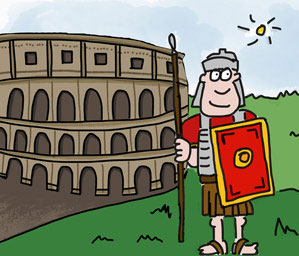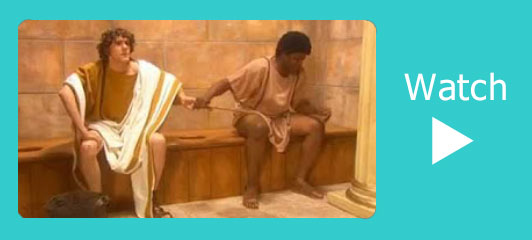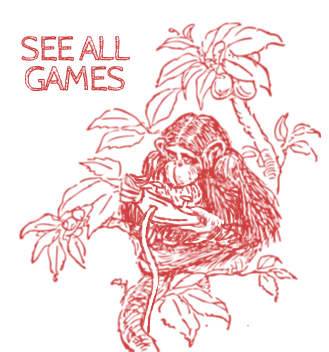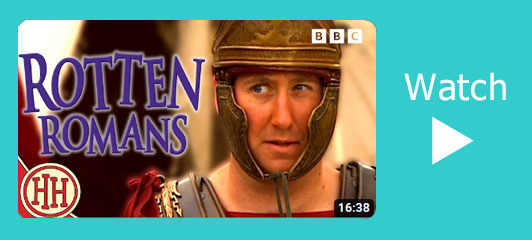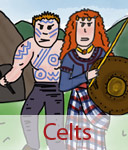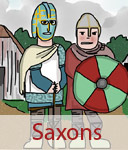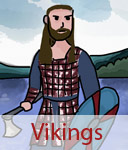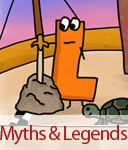The Romans facts
The Romans facts for kids KS2 learning at Primary School. Homework help with the history of Romans, the Roman Empire and places to visit in the UK where you can learn more about the Romans.
Time: 750BC - 500AD
Who were the Romans?

The story of Rome begins with a famous legend about two twins called Romulus and Remus. According to the tale, their uncle wanted them gone, so he put the babies into a trough and set them afloat on the River Tiber. Miraculously, they were rescued by a wolf and a woodpecker, who looked after them. Later, a kind shepherd found the twins and raised them as his own.
When they grew up, Romulus and Remus returned to the area where they had been abandoned and decided to build a city. But the brothers argued over who should rule it. Romulus marked out a boundary for the city, and when Remus crossed it, Romulus became so angry that he killed his brother. Romulus then named the city Rome, after himself.
Rome’s population began to grow nearly 3,000 years ago, and over time it became the most powerful city in Italy. At first, Rome was ruled by kings, but after the last king was driven out, the Romans decided to choose their own leaders. A group of men from the most important families formed the first government. This was the start of the Roman Republic, which eventually grew into the Roman Empire, as Rome expanded to control all of Italy and, later, much of Europe, the Middle East, and North Africa.
The Roman Empire
After the Roman Republic grew stronger, Rome became the Roman Empire, one of the largest empires in history. Over the next 500 years, the Romans conquered many countries across Europe, the Middle East, and North Africa. The Romans were very powerful and had a strong, well-trained army, which helped them win battles and take control of new lands. They could be ruthless, and sometimes they used fear and punishment to keep people under control. But the Romans didn’t stop—they wanted to expand their empire even further.
Not everyone accepted Roman rule, though. One of the most famous rebellions was led by a gladiator slave called Spartacus. Spartacus gathered a group of other gladiators and slaves and rebelled against the Romans, winning several battles as they travelled across the empire. They became famous for their courage and determination, and many people admired their fight for freedom.
Despite their bravery, Spartacus and his followers could not capture Rome itself. After a year of fighting, Spartacus was killed in battle, and the Romans punished the remaining rebels by crucifixion, sending a clear message about the power of the empire.
 Bitesize: Roman Empire
Bitesize: Roman EmpireFind out what life was like in ancient Rome and in the army.
 History on the net
History on the netThis website covers a huge amount of information on the Romans. Topics include Roman society, food, clothing, housing, gladiators and more...
What was Roman life like?
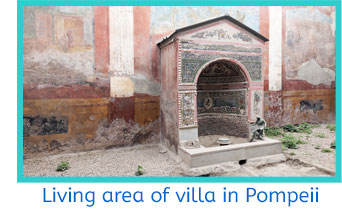 Life in Ancient Rome could be very different depending on whether you were rich or poor.
Life in Ancient Rome could be very different depending on whether you were rich or poor.
Rich Romans
Rich Roman families lived in large, fancy houses called villas. These houses had many rooms, decorated with colourful mosaics on the floors and beautiful paintings on the walls. They had courtyards with gardens and fountains, and sometimes even private baths! The wealthy wore clothes made of soft wool or linen, and only the richest could afford silk. They ate lots of different foods, including meat, fish, fruit, bread, and cheese. Wealthy Romans even enjoyed special dinners with several courses, sometimes with exotic ingredients brought from across the empire.
Poor Romans
Poor Romans lived in small, crowded apartments called insulae. These buildings were often made of wood and mud, and fires were a big danger. Families had much less space and fewer possessions. They ate simple food, mostly bread, porridge, vegetables, and occasionally meat. Life could be hard, and children often worked from a young age to help their families.
Family life
Family was very important in Roman society. Fathers, called paterfamilias, had lots of authority over their families. Mothers looked after the home, children, and slaves if they had them. Boys and girls were educated differently: boys often learned reading, writing, and numbers, while girls were taught skills for running a household, though some rich girls received the same education as boys.
Clothes
Romans wore tunics as everyday clothing. Men sometimes wore a toga over their tunic for special occasions. Women wore a long dress called a stola. Jewellery, hairpins, and sandals were common for those who could afford them.
Religion
Romans believed in many gods and goddesses, like Jupiter (king of the gods), Mars (god of war), and Venus (goddess of love). They went to temples to pray, make offerings, and hold festivals. Later, Christianity spread across the empire and eventually became the main religion.
Roman Entertainment
Romans loved to have fun and enjoyed many different types of entertainment. They spent their free time eating, drinking, and gambling, or watching exciting events like theatre plays, chariot races, and gladiator fights. These activities were important for relaxing, socialising, and showing off wealth and status.
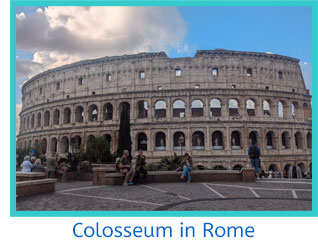
Chariot Races and Gladiators
Chariot races were held in large stadiums called circuses, the most famous being the Circus Maximus in Rome. Skilled charioteers raced their horses around the track at high speeds, and the crowd cheered loudly for their favourite teams. Gladiator fights took place in arenas like the Colosseum, where trained fighters battled each other or wild animals. Some fights were staged for entertainment, but they could be very dangerous and even deadly.
Public Baths
Going to public bath-houses was another favourite pastime. Bath-houses were more than just places to get clean—they were like ancient leisure centres! Romans could swim in hot and cold pools, exercise in gyms, and even get massages, haircuts, or beauty treatments. Before bathing, people rubbed their bodies with olive oil and scraped it off with metal tools called strigils to clean themselves. Bath-houses were also a place to meet friends and talk about business or politics, making them a very social part of Roman life.
 Roman Baths - Bath, UK
Roman Baths - Bath, UKThe baths were constructed around 70 AD as a grand bathing and socialising complex. It is now one of the best-preserved Roman remains in the world.
The Roman Army
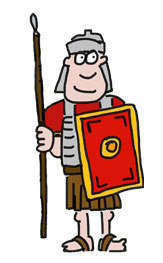 Over the next 150 years, the Romans continued to take control of even more land, building one of the largest empires in history. One of the main reasons they were so successful was their strong, well-organised army. Roman soldiers were highly trained and could carry out complex attacks. They could surround an entire city, cutting off food and water so no one could escape, and then eventually force their way in.
Over the next 150 years, the Romans continued to take control of even more land, building one of the largest empires in history. One of the main reasons they were so successful was their strong, well-organised army. Roman soldiers were highly trained and could carry out complex attacks. They could surround an entire city, cutting off food and water so no one could escape, and then eventually force their way in.
Roman soldiers were incredibly disciplined and could march over 50 km (30 miles) in a single day, carrying all their weapons and supplies. Any healthy man between the ages of 17 and 46 could be called to join the army, and once enlisted, they usually had to serve for 25 years. This long service meant soldiers became very skilled at fighting, building forts, and keeping order in newly conquered lands.
The Roman army was not only about fighting—they also helped build roads, bridges, and forts, which made it easier to move troops and control the empire. Their organisation, training, and teamwork made the Romans almost unbeatable for hundreds of years.
Roman Emperors
Roman Emperors were powerful leaders who controlled the empire and made important decisions about its land, army, and people. Over the centuries, there were 147 Roman Emperors, some famous for their achievements, and others for being cruel or eccentric.
A few of the most well-known include:
-
Nero – Known for being a very unpopular emperor; some stories say he played music while Rome burned!
-
Trajan – Expanded the Roman Empire to its largest size, reaching as far as modern-day Romania and Iraq.
-
Hadrian – Built Hadrian’s Wall in northern Britain to keep out invaders and protect Roman territory.
-
Marcus Aurelius – Famous as a philosopher-emperor, he wrote books about how to live a good life while leading the empire.
Some emperors were brilliant rulers who improved Rome, while others were cruel or caused trouble. Despite this, the idea of the emperor kept the Roman Empire strong and organised for hundreds of years.
Who was Julius Caesar?
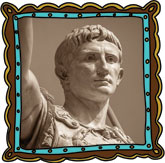
As the Roman Republic grew more powerful and took control of more land, the Senators often argued about how to run the empire. In 49 BC, a famous general named Julius Caesar marched his army into Rome and took control. Caesar was very popular and tried to make peace, but many Senators were worried he might become a king—something Romans had always disliked. In 44 BC, they assassinated him in the Senate to try to stop him from taking too much power.
After years of fighting among Caesar’s supporters and rivals, his great-nephew Octavian emerged victorious. He took the name Augustus and became the first emperor of Rome, marking the beginning of the Roman Empire. Augustus ruled wisely for over 40 years, expanding the empire and bringing peace after many years of war.
Roman Britain
By 55 BC, the Roman Empire had reached Britain, which was controlled by Celtic tribes. Julius Caesar led the first invasion, but the Celts fought back fiercely, and the Romans had to retreat. About 100 years later, under Emperor Claudius, the Romans returned. This time, they succeeded and took control of southern Britain.
The Celts resisted, but the Roman army was very powerful. They defeated the tribes again and again, using clever strategies, strong weapons, and excellent organisation. However, the Romans never fully conquered Scotland, where fierce warrior tribes lived. To protect their empire, the Romans built a great wall called Hadrian’s Wall in northern England. It is 117 kilometres long and 4.5 metres high in places. This wall stretched across the country and was meant to keep out invaders and control trade and travel.
Roman towns and roads
The Romans built towns, forts, and villas across Britain. Towns like Bath, Colchester, and London became important centres for trade, government, and daily life. They also built straight, durable roads that connected towns and forts, allowing the army to move quickly and traders to carry goods across the land. Many of these roads were so well-built that parts of them are still used today!
Roman Inventions and achievements
The Romans were great inventors and engineers. They built aqueducts to bring fresh water to towns, public baths for hygiene and socialising, and amphitheatres for entertainment. They also introduced coins, written laws, and calendars, which made life more organised and fair. Roman building techniques, such as using concrete, let them create large, strong structures that could last for centuries.
Thanks to the Romans, life in Britain changed a lot. They brought new ways of farming, new foods, and new styles of houses and clothes, leaving a lasting mark on the land and culture.
 Colchester Castle - UK
Colchester Castle - UKA visit to Colchester Castle is better than ever before with interactive displays and star exhibits, like the Colchester Gladiator Vase and Fenwick Hoard of Roman treasure.
 Hadrians Wall - UK
Hadrians Wall - UKVisit parts of Hadrian’s Wall in northern England today—some stones are over 1,900 years old.
What happened to the Romans?
By around 200 AD, the mighty Roman Empire began to weaken. The army, which had once kept the empire strong, started choosing their own emperors and fighting among themselves. This caused confusion, and it became harder to protect the empire from enemies.
In 395 AD, the Roman Empire was split into two parts: the Western Roman Empire, with its capital in Rome, and the Eastern Roman Empire, with its capital in Constantinople (modern-day Istanbul). Splitting the empire made it even harder to defend against attacks and keep control of such a huge area.
Over the next few decades, the Western Empire faced many invasions. Groups of people called barbarians, who lived outside the empire, began to attack Roman lands. One famous chief, Odoacer, led the Visigoths to capture the city of Rome and declared himself King of Italy, which marked the end of the Western Roman Empire in 476 AD.
The Eastern Roman Empire, also called the Byzantine Empire, continued for another thousand years, keeping Roman traditions alive in art, law, and government. Even though the Western Empire had fallen, many Roman ideas, roads, buildings, and systems of government influenced Europe for centuries to come.

